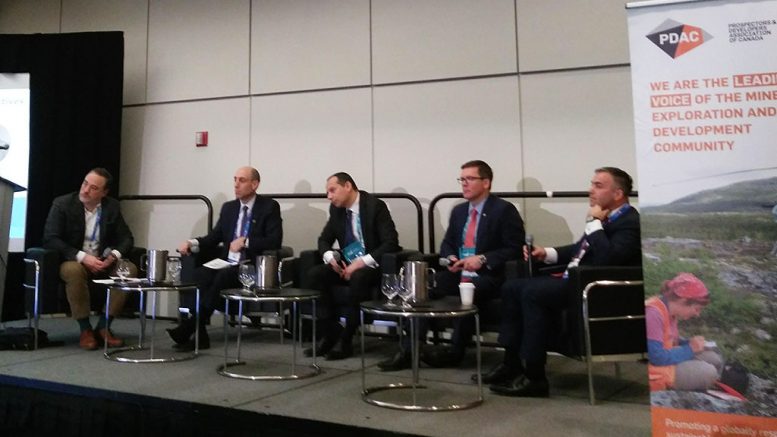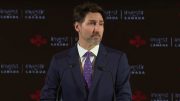In a capital markets session at the Prospectors and Developers Association of Canada, investment bankers from BMO Capital Markets, TD Securities, CIBC Capital Markets and RBC Capital Markets discussed the impact the outbreak of the coronavirus, or Covid-19, is having on markets and banking. Anthony Vaccaro, group publisher of The Northern Miner, moderated the session, with Michael Faralla, managing director and head of global mining at TD; Ilan Bahar, managing director and head of global mining BMO; Chris Gratias, managing director and head of global mining at CIBC; and Ryan Latinovich, managing director and head of global mining at RBC.
Anthony Vaccaro: I think it’s fair to say that the coronavirus is a classic Black Swan and it’s had a devastating impact on markets. How do you see this affecting markets in the medium and long-term?
Michael Faralla, TD Securities: There are a couple of things. Two different parts to the metals market especially as it relates to the TSX relative to the gold sector, which is an important part of the market for us, and gold is really more of a financial instrument than a physical or industrial commodity, and then we’ve got the industrial commodities, base metals and bulks. As you’ve seen in the last three or four weeks, as Covid got worse and worse you saw gold behaving as a typical safe-haven asset, and we saw gold prices going up and gold equities responding and reasonably positive for the gold price.
Conversely, industrial metals, base metals, are looking forward to an industrial slowdown globally, and we’re starting to see that data come through. I think there was PMI data out today for the U.S. that showed PMI for February down to 35%, which is the lowest number on record, so coronavirus impacts in the short term industrial production, and we’ve seen base and bulk prices going lower. So there’s definitely that divergence in the market in the short term and in the long term.
Anthony Vaccaro: Ilan how do you see it impacting in terms of the business of banking?
Ilan Bahar, BMO Capital Markets: Sure so I think it’s early days. It is hard to predict where ultimately it ends up. For us, the near-term impact is the impact on commodities that Michael spoke about and subsequent to that is the impact on financing. It’s a difficult environment for investors to make decisions. The markets swing with such volatility each day that even if you think about personal investments it’s hard to make choices. It’s hard to know which way the market will go so, from the perspective of financing mining companies, currently, it’s very challenged.
We need less volatility in the market for financing to return to more sustainable levels. The other impact we think about is the impact on our M&A business. It’s again early days, the day to day moves in commodity prices don’t necessarily drive what mining companies choose to do. There are broader strategies around the transactions they pursue, the strategy that they have, their long-term planning. Many of the mining companies make decisions on the basis of lower commodity prices than spot, in fact, most do, so on the M&A side, we aren’t currently seeing an impact despite what the coronavirus is doing. Our business is still very busy, but that may change, we’ll see what happens in the coming weeks and months.
Anthony Vaccaro: What metrics are you looking at that indicate it might be getting more serious or less serious.
Chris Gratias, CIBC Capital Markets: You can look at lots of data. And it’s not perfect information — it’s changing quickly. What’s the longer-term impact? How long could this last? And the best example we could look at and our firm has done some work on the impact that SARS had. So back in 2003, you can specifically look at GDP data, so, for example, in Ontario, which we all know was pretty hard hit by that, you saw there was steady steady consistent GDP growth, and then for two quarters it went negative right around SARS. So this is already bigger than SARS and continuing to grow, so there will absolutely be an impact, and when it bounces back it doesn’t catch up. That growth just goes straight out of the market for those quarters. We’re trying to track that data, but there’s definitely going to be a hit to GDP for sure.
Ryan Latinovich, RBC Capital Markets: I don’t really have much to add, but I’d underscore a couple of points. First off, as has been mentioned, many of the companies we deal with on the M&A side, this is a multi-generational business that they’re trying to build, planning through months and what could be quarters here of pretty significant volatility does blunt some of the new-term enthusiasm of many of these types of transactions or longer gestation periods and people seem to look through that at longer-term commodity prices. That’s where you end up in a bit of a riddle because predicting longer-term impacts of a situation like this, and I’m not a medical professional, but it certainly has the initial momentum to look like it could get significantly worse. That will cause people to pause as it relates to what the longer-term new version of reality for commodity prices is.
Clearly, on an economic basis, and the slowdown and the impacts that that can have, [a] very direct read-through on base metals and industrial metals, as Michael said. The interesting part on precious metals, which is a big part of our business, it’s not as clear. It’s like a second derivative type of argument in terms of how that will actually play out in the longer term for things like gold as a safe haven. Volatility, uncertainty, tend to be positive for the precious metals, but as we saw on Friday, for instance, it can be a pretty significant negative downdraft on the gold price on just one day. On at least our desk, people are seeing some profit-taking and some covering in what could be a longer term macro-economic backdrop that has people searching for sources and places to make money. So those things are very tricky to predict in the long-term, but clearly in the near-term people are taking pause.
Anthony Vaccaro: We’ve seen gold come back a little bit today. But is the historical precedent that when things get so bad that it just becomes the U.S. dollar again and that’s what we saw on Friday? Every one wanting nothing but U.S. treasuries?
Ilan Bahar: Over the last 50 years, we’ve seen times when the safe haven is gold, and we’ve seen times when the safe haven is the U.S. dollar and U.S. treasuries, and it’s hard to predict how the market will act. But when we see money flowing into treasuries, generally that’s not good for commodities – and it’s not just gold, it’s across the board. So you could see more of that, that wouldn’t totally surprise me.
Michael Faralla: One interesting dynamic that we haven’t talked about is, going back to the global financial crisis in 2008, this is certainly not the global financial crisis, but the correction that we just experienced last week is certainly quite big and quite dramatic, and you have to go back to 2008 to see as sharp a decline in the equity markets. But back then every commodity fell, including gold, even though it was viewed as a safe haven for the reasons that Chris and Elan talked about, but following that we saw government stimulus come out, whether it be central banks cutting, quantitative easing and in particular big stimulus packages in economies like China, which actually then drive outsized demand for commodities, particularly copper, iron ore, coking coal, steel prices all running during that period.
So an important part of what’s going to happen here with commodity prices, in the medium term, will be around how governments respond to this. There’s been lots of market commentary around central banks shifting from a neutral or tightening stance to looking at loosening. The Bank of Canada on Wednesday and the US Federal Reserve shortly after that. And then I think you have to look more to the medium and longer-term fundamentals, and mine imbalances for commodities, and there are lots of industrial commodities where there are reasonably large deficits projected three to four years out. So as things normalize again, and, particularly if we see stimulus, that will return markets more back to normalization, and then you can refocus again on longer-term, where those fundamental deficits and requirements for higher prices testing more supply becoming a reality.






Be the first to comment on "PDAC: Investment bankers discuss coronavirus impact"